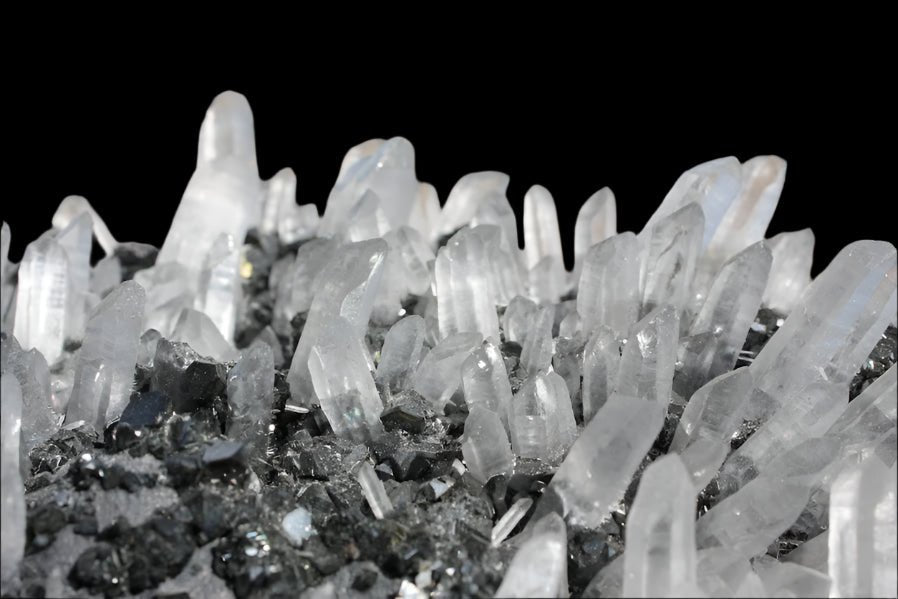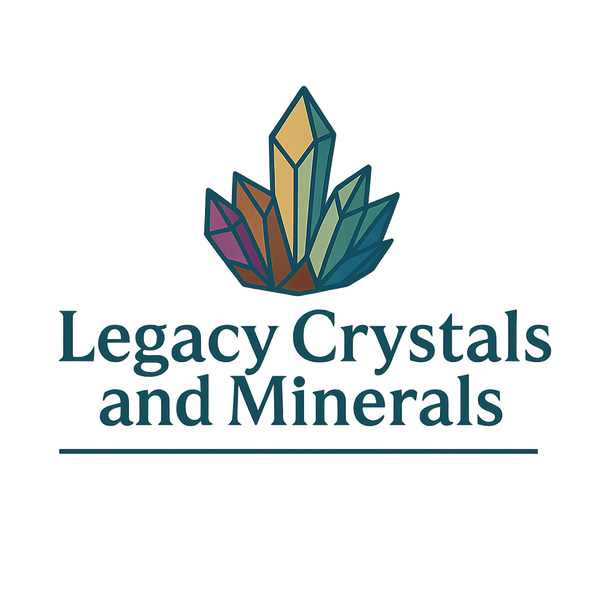
Quartz Clusters: Types, Origins & Energetic Applications
Share
Quartz is one of the most abundant minerals on Earth, yet its beauty, diversity, and energy make it endlessly fascinating. From dazzling collector specimens to essential tools in spiritual practice, quartz clusters hold a special place in the mineral world. In this guide, we’ll explore quartz geology, formations, global localities, collector value, and metaphysical applications—showing why quartz is a mineral for everyone.
What is Quartz?
Quartz (SiO₂) is a silicate mineral that crystallizes in the hexagonal crystal system. It is one of the most common minerals on Earth’s crust but also one of the most varied. Quartz can appear clear, smoky, purple, golden, pink, or even multicolored depending on trace inclusions and geological conditions.
Quartz clusters form when multiple crystals grow together on a shared matrix. These formations often show sharp terminations, sparkling luster, and the interconnected growth that makes them so appealing for both collectors and healers.
Types of Quartz Clusters
Quartz is incredibly diverse. Here are the main types of quartz clusters that attract collectors and metaphysical practitioners alike:
- Clear Quartz: Transparent crystals known as the “Master Healer.” Collectors prize clarity, while seekers value its amplifying energy.
- Amethyst: Purple quartz colored by iron impurities. Famous from Brazil, Uruguay, and Namibia, amethyst clusters are among the most recognized in the world.
- Citrine: Golden quartz, often heat-treated from amethyst. Natural citrine clusters are rarer and highly collectible.
- Smoky Quartz: Brown to black quartz formed by natural radiation. Loved for its grounding metaphysical energy and dramatic collector appeal.
- Rose Quartz: Usually found in massive form, but rare clusters exist. Known for its pink hue and associations with love and compassion.
- Phantom Quartz: Clusters with “ghost-like” outlines inside the crystals, showing earlier stages of growth frozen in time.
- Included Quartz: Quartz containing hematite, rutile, chlorite, or other minerals. These inclusions increase both beauty and metaphysical depth.
Famous Quartz Localities
Quartz clusters are found worldwide, but certain localities are especially prized for their unique qualities:
- Brazil: A global powerhouse for clear quartz and amethyst clusters. Large cathedral formations and richly colored amethyst geodes are iconic exports.
- Uruguay: Produces some of the deepest purple amethyst with high luster, often cut into geodes and display clusters.
- Fujian Province, China: Known for dramatic quartz clusters with hematite and pyrite associations. Collectors prize their aesthetic contrast.
- Tamil Nadu, India: Quartz with iron inclusions and vibrant clarity, adding both geological and metaphysical appeal.
- Goboboseb Mountains, Namibia: Famous for scepter amethyst crystals, often combined with smoky or clear growths.
- Arkansas, USA: Clear quartz crystals with exceptional clarity. Clusters from Mount Ida are especially collectible.
- Himalayan Region: Quartz mined at high altitudes, often carrying unique energy signatures prized by metaphysical buyers.
Collector Appeal of Quartz Clusters
Quartz clusters may be abundant, but not all are equal. Collectors value quartz based on:
- Clarity: Transparent crystals with minimal inclusions are more sought-after.
- Termination Quality: Sharp, undamaged crystal points are essential for high-value specimens.
- Size & Formation: Large clusters with balanced, aesthetic growth are more desirable.
- Rarity of Locality: Quartz from closed mines or famous districts increases long-term value.
- Unique Features: Phantoms, enhydro bubbles, and dramatic inclusions make clusters truly one-of-a-kind.
For serious collectors, provenance is key. A quartz cluster labeled simply as “from Brazil” is less valuable than one specifically tied to “Minas Gerais, Brazil” or “Goboboseb, Namibia.”
Metaphysical Benefits of Quartz Clusters
Quartz clusters are powerful energy tools. Their interconnected crystals radiate energy in multiple directions, making them ideal for:
- Amplification: Clear quartz is believed to boost the energy of other stones and intentions placed near it.
- Cleansing: Clusters can neutralize negative energy and recharge smaller crystals when placed nearby.
- Space Clearing: Perfect for harmonizing energy flow in homes, meditation spaces, or work areas.
- Meditation Support: Enhancing focus, clarity, and spiritual connection.
- Healing Practices: Used by Reiki practitioners and energy workers to direct and amplify healing energy.
Different quartz types are used for specific purposes: amethyst for intuition, smoky quartz for grounding, citrine for abundance, and clear quartz for overall balance and amplification.
How to Work with Quartz Clusters
If you’re using quartz for metaphysical purposes, here are a few ways to incorporate it into your practice:
- Crystal Grids: Place a quartz cluster in the center of a grid to amplify its energy.
- Home Decor: Position clusters in living spaces to enhance harmony and positivity.
- Meditation Altars: Use clusters as a focal point for grounding or expanding awareness.
- Crystal Care: Rest smaller stones on clusters to cleanse and recharge them.
Quartz at Legacy Crystals and Minerals
At Legacy, we curate a wide range of quartz specimens, from museum-grade collector clusters to polished spheres and carvings. Each piece is selected for its natural beauty, authenticity, and ability to inspire.
Our collection includes:
- Quartz with hematite and pyrite from Fujian Province, China
- Amethyst clusters from Namibia and Brazil
- Smoky quartz from high-altitude localities
- Phantom and included quartz with rare growth features
Shop Quartz Collection | Explore More Guides
Key Takeaways: Quartz Clusters at a Glance
- Quartz is abundant but endlessly varied, making it collectible and energetically versatile.
- Collectors value clarity, terminations, locality, and unique features like phantoms or inclusions.
- Seekers value quartz for amplification, cleansing, grounding, and spiritual connection.
- Locality matters: Brazil, Namibia, India, China, the Himalayas, and the U.S. each produce distinct quartz specimens.
- Quartz clusters are accessible to both seasoned collectors and beginners entering the mineral world.



